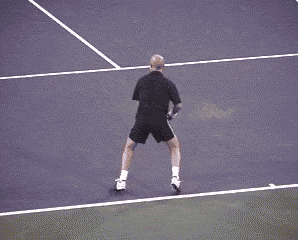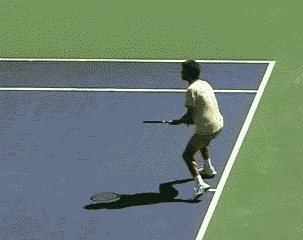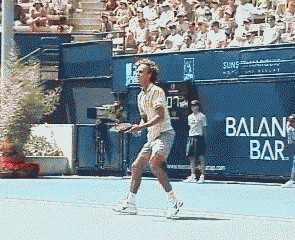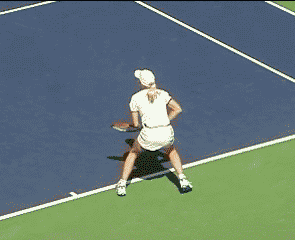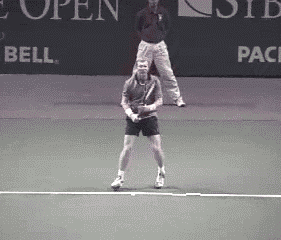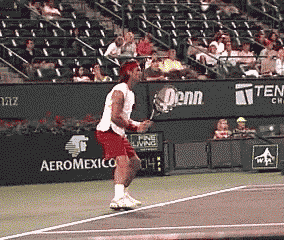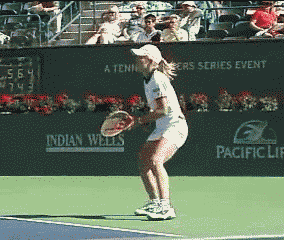|
TennisOne Lessons Hitting Off the Back Foot Doug Eng EdD, PhD Years ago, if you took a lesson, you were probably taught to keep your feet on
the ground. You were taught to step in and transfer your weight to your front or left foot on your forehand (if you are
right-handed). More recently, if you
took a lesson, you might have been taught to transfer your weight from the right foot
to your left foot on the forehand (if you are right-handed). Your pro might let
you come off the ground a bit as long as you shifted your weight to the front
foot.
You won’t want to hit off the back foot in most attacking situations. So, you must consider whether you are ten feet behind the baseline, ten feet inside the baseline, whether you have a low ball or a wide ball. Clearly there are situations where you should step in. Let’s address the cases for stepping in and hitting off the back foot. Let’s address the latter first. In this article, I will specifically address a right-handed player hitting a forehand groundstroke. But the same applies to a backhand or lefty. When to Step In There are several situations when you really should avoid hitting off the back foot. The first is on a short ball you can attack, e.g., an approach shot or an outright winner inside the baseline. Hitting off the back foot elevates your shot. When you attack, you want to give your opponent less time but elevating your shot increases the ball height of trajectory. Second, hitting off the back foot frequently gives the club player a little less power. Any time you want to attack, you should drive through from the right foot to the left. There is one more situation you clearly want to get down on your front foot. Most passing shots should be struck lower than the typical groundstroke. Therefore, it is very important you stay down on the passing shot. It is actually quite natural to do so since most approach shots and volleys are either hit aggressively or with slice and hence, stay down lower than a heavy topspin groundstroke. So your contact point on the passing shot tends to be lower than usual. When to Hit Off the Back Foot
Tennis is a game of attacking, defending, and neutralizing. It is also a game of spin, height, and percentages. If you are several feet behind the baseline, you rarely can hit an attacking drive. One of your best options is to add height to your shot so it goes deeper as seen in Figure 1. A problem with adding height is that, for many people, they will hit out. So they end up hitting softer in the form of a high moonball by opening up the racquet face. Instead of moonballing, try keeping your swing path the same but change the elevation of your swing by driving off your back foot. Your shoulders should not be level to the ground but the front (left shoulder for a righty) shoulder should be higher than the back shoulder as if you are climbing up a hill sideways. Your weight should be on the back foot and you should hit upwards as shown in the video of Guga below. If you simply open your racquet face, you will lob or hit long. So you are not trying to push the ball upwards but drive it with extra height while keeping the spin and pace.
Most shots should start with loading on the back foot. In a great forehand, power is created off that foot. As the player tries to add spin and pace, the force of the swing often results in the front foot lifting as the racquet accelerates upwards.
In the first case, you are wide of the court and need time to get into the court. You need to hit your crosscourt groundstroke higher than normal to gain time.
Second, if your opponent hits a deep ball off the baseline and you are forced back. Adding a reverse follow-through to hitting a bit off the back foot will neutralize your shot effectively. And last, if you are deep behind the baseline. Lifting the front foot elevates your shot without changing the racquet path relative to your body. The gravity step is one of the fastest ways to recover back into the court. When forced wide, plant off the outside foot and drive the ball. On your forward swing, your inside foot will lift off the ground which allows you to quickly shift your weight back into the court. Often the pros when forced to move wide will use this footwork pattern with an extra step off the outside foot which acts as a brake.
Haas takes a small skip step with the right foot and creates only a small gravity step. Note that Safin adds an extra braking step but his inside foot lifts and his body leans farther back to the center of the court after his shot. He actually brings the left foot up and almost into the planted right foot which creates a leaning or gravity effect. Think of a speed skater pushing off with the outside foot and lifting the inside foot. A great drill is to do one-legged alley hops. Practice laterally jumping across the doubles alley. When you jump to the right, land only on your right foot. When you jump to the left, land only on your left foot. Let the non-landing leg hang up a little in the air and push off the one foot back across the alley. Then do the same but bring the foot in the air closer to the planted foot. You will feel greater force back across the alley and hence, recover more quickly back into the court. The Negative Turn Step
When your opponent drives deep into the center of the court and you are forced backwards, learning how to use this backwards movement can make your shots more effective. Many people try to either hit off a square or closed stance where they lift the front foot but fail to complete their shoulder and hip turn. Others simply try to open their stances and get down low. But that also loses power. By simply lifting the front foot and moving it backwards, you can create more space and time to drive the ball. You also don’t sacrifice your angular momentum, a key source of your power. Note he is fairly planted on the right foot and only the left foot swings back to create angular momentum and give more room to hit. I call it the negative turn step since he simply takes a negative step back and then turns off the loaded right foot. A variation of the negative turn step is the spin step where right foot on the forehand swings forward and the left leg swings back. Very athletic players do this footwork in mid-air. You can see how Justine Henin
Here’s how to practice the reverse step: first practice moving backwards with your racquet in the unit turn or backswing position. Then as you are moving backwards, drop a ball slightly behind your normal contact point. Step backwards on the right leg (for a right-handed person), hit the ball, and let the left leg go farther back. You should turn your shoulders and hips fully from the right to the left like Justine. The Climb Step The last variation is what I call the climb step. Use this footwork to help add extra height to the looping groundstroke when you are ten feet behind the baseline. The purpose is to avoid hitting a short ball. Your alternatives from that far back are either to play an unaggressive moonball or to hit normal – and often short unless you can really let it fly.
In this case, he isn’t ideally playing the shot since he is only two feet behind the baseline and doesn’t need to create the extra elevation. As big as Andy Roddick hits, he often uses the straight-legger to help him hit upwards and recover back into the court. Both the straight-legger and the stair climb serve similar purposes to elevate the neutralizing groundstroke. Very similar principles apply to the backhand. Justine Henin often drives the ball very powerfully off the back foot. Also Carlos Moya shows us a backwards-moving climb step.
Conclusion It is important to realize that different situations require different technique and footwork. Some players try to step into every ball, or hit from an open stance every shot, or hit every ball at a certain height. Those are tactical and technical mistakes. It is also important to realize that hitting off the back foot should not be your main course of action. However, many juniors under 14 years old don’t have the size or power to drive through the ball and often must push the ball upwards off their back foot whether on a neutral or attacking rally. Regardless, it should be an important technique in your game especially on neutral baseline rallies. Remember, tennis occurs in a changing environment where every ball is slightly different. Your comments are welcome. Let us know what you think about Doug Eng's article by emailing us here at TennisOne.
Doug Eng EdD PhD coaches men's tennis at Tufts University. During the summer, he directs at the Tennis Camps at Harvard. He has received divisional Pro of the Year honors from the PTR and USPTA and several national award. Doug completed the USTA High Performance Coaches program and frequently runs educational and training programs for coaches. Doug also writes and speaks on tennis and sport science. |

